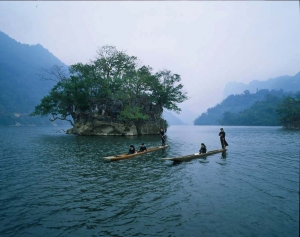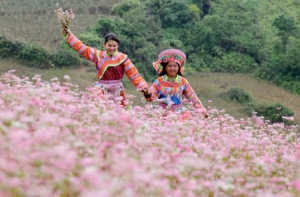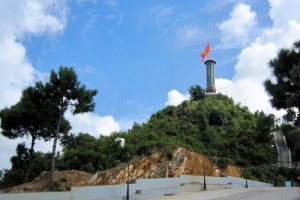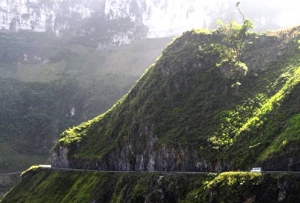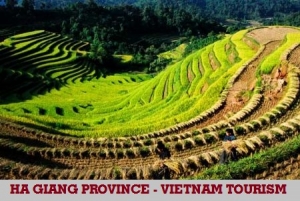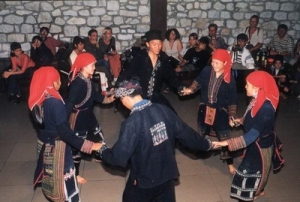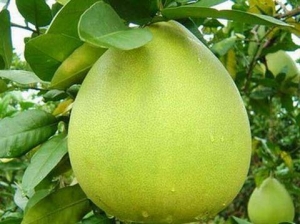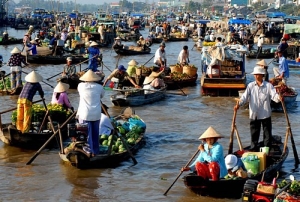
Asia Pacific Travel Team
Ba Be Lake- “Precious Jade of Vietnam”
Lying in the middle of a vast limestone mountain range of Ba Be District, Bac Kan Province, 240km from the north-west of Hanoi.Ba Be Lake is dubbed a "precious jade of Vietnam” and one of 500 lakes recognised as worthy of attention.
Ba Be itself is actually three smaller lakes joined together including Pe Lam, Pe Lu and Pe Leng. The climate is cool with an average temperature of 22oC. The best time for visitors in Vietnam travel to visit the area is during the dry season, which is during winter and spring. The area was established as a national preserved forest and tourist center in 1978.
Ba Be Lake is the biggest one in the Northern of Viet Nam. It’s 8 kilometer long, 3 kilometer wide, 20m -30m deep and narrow in the middle. There are two small islands emerging in the middle of the lake. One of them looks like a horse, so it is called An Ma. The area has a lot to offer, including waterfalls, rivers, valleys, lakes, and caves all set amidst picturesque landscapes. Ba Be Lake is surrounded by many ancient trees, from which several varieties of precious wood are obtained. Up to 30 animal species such as wild pigs, bears, panthers, monkeys, and birds inhabit the area.
Ba Be Lake, located 145m above sea level, are among the largest natural lakes in Vietnam with a total surface area of 500ha. The surface of the lake was tranquil. Visitors joining tours in Vietnam will have an unforgettable stay in the mountains by the lakes, enjoying sightseeing boat trips, hikes, and water sports.
If you plan to visit the Northen provinces of Vietnam, Ba Be lake should be added to your itinerary.
Best time to travel Ha Giang
During this time, the scenery is magnificent with mountaintops hiding in the cloud and wild peach flowers blooming everywhere. Moreover, the weather during the Tet holidays is very comfortable with little rain and cool air, so that tourists in Vietnam tours do not have to carry raincoats or umbrellas with them.
There are also a lot of unique and attractive festivals to celebrate the New Year during this time. Hence, visitors with Vietnam travel guide can have a chance to know more about the ethnic culture in Ha Giang and enjoy the festive atmosphere of various ethnic groups. Lastly, as this is the dry season and the routes to Ha Giang mostly go along the side of mountains, the roads are much safer for trip.
Surprised at the buckwheat flower season in Ha Giang
Vietnam Tourism will take you go to buckwheat flower season at north pole's Vietnam - Dong Van stone plateau, Ha Giang Province. The plateau was recognized by the UNESCO as one of the 77 geological parks in the world and the second in Southeast Asia.
With diverse cultures and traditions of nearly 20 ethnic groups, Dong Van plateau is an interesting destination for tourists in Vietnam travel. These ethnic minorities live on cultivating rice along the basins of the Nho Que River and corn on the rocky mountain slopes. Life may be tough, but most of the local ethnic groups still stick to their century-old traditions.

Dong Van stone plateau with extreme winter is still bright with buckwheat flowers's petals each winter.


Each winter, in the cold wind, type of white, pink small flowers bloom on the fields, slopes.

The cold and deserted plateau wear a new shirt color welcome yellow sunlight.
The plateau attracts many couples who come here to take wedding pictures.
Photographers and travelers in Vietnam travel can't force by its beauty, too.


Vitality of the plateau
For tours in Vietnam, making Dong Van tour and feel!
Hoang Su Phi- Charming tourists in Vietnam Travel by The Pristine Beauty
Hoang Su Phi of Ha Giang Province has more than 55.800 people living in 9.700 households with 25 communes. A third of its people live in the highland, thus the lives are so difficult. The district is famous for its terraced paddy-fields, October is the best month to visit and to witness the beauty of harvest time when all the terraced paddy-fields turn yellow with ripening rice.
Traveling to Hoang Su Phi, visitors in Vietnam travel have a chance to enjoy the spectacular natural majestic, relax in the comfortable atmosphere with fresh mountain forests and the same message stream block please ring. Hoang Su Phi has 4 cultural and tourism villages in Nam Hong, Giang Thuong, Phin Ho và Lng Giang. Here visitors are welcome to rest in the houses of local people.
Through exchange, tourists in Vietnam travel will learn about daily life of people as well as the features of each culture and ethnicity of each village. Guests can also learn some handicrafts such as traditional weaving, dyeing, paper made with straw.
Lung Cu - A High Forehead of The Motherland- Ha Giang Vietnam
Driving over 400km from Hanoi following National Highway 2 and 4C, the rocky plateau of Dong Van awaits visitors in Vietnam travel, with mountain paths like blood vessels sticking to the land standing between them and the summit of Lung Cu.
 From a distance, Lung Cu is a spectacular sight, with the view dominated by giant boulders and the national flag flying above Dragon Mountain, all set to the backdrop of magnificent forests.
From a distance, Lung Cu is a spectacular sight, with the view dominated by giant boulders and the national flag flying above Dragon Mountain, all set to the backdrop of magnificent forests.
The flag tower itself stands proudly 1,600m above sea level. Its design is an imitation of the Hanoi Flag Tower, with eight bronze drums guarding the sides of the octagonal tower. The national flag adorning the top of the 135-stair tower has an area of 54m², symbolizing the unity of Vietnam’s 54 ethnic groups.
From the top of Dragon Mountain, the paddy fields and earthen-walled houses dot the sumptuous panorama, interrupted by two lakes that are said to be the dragon’s eyes. Even though people say that Lung Cu is a ‘thirsty’ land, the lakes never dry out.
The houses in Lung Cu also betray the superstitions of the people who live in them. Charms hang over the doors to expel demons and evil spirits, and the ancestral altar is carefully placed opposite the main door. The houses are usually open plan, but when newly-weds are welcomed into a family, the hosts use fabric to make a private compartment for them to enjoy.
Lung Cu Commune is home to nine villages, situated at a height of between 1,600-1,800m above sea level. In the winter, the weather is very cold, and sometimes it even snows. There are seven ethnic groups in Lung Cu. They are very friendly and hospitable. Visitors to their houses are considered distinguished guests, even if they are strangers. A bowl of their maize wine will soon warm you up.
Most ethnic people in the area cultivate rice and the Mong and Lo Lo still preserve the traditional weaving industry with flax fibres.
Lung Cu is also the land of the peach, the plum, tea, honey wine and Thang Co (horse meat hot pot). The bustling markets where the honey-yellow sunlight has never changed, the cheerful, shy smiles of the ethnic girls in colorful, handmade dresses, the playful grins on the children’s faces, and the welcoming nature of the people as a whole never fail to charm visitors in Vietnam travel.
Ma Pi Leng Pass on Dong Van Stone Plateau Geo- Park
Ma Pi Leng Pass, located between Meo Vac Commune and Dong Van, is a 15-kilometer canyon road above the Nho Que River, which weaves its way like a silver ribbon through limestone ravines.
The pass' peak is aptly named Cong Troi (Heaven's Gate), and is the best place for tourists in Vietnam travel to enjoy a panoramic view of the valley below, particularly on a late afternoon when you can see a beautiful sunset overlooking the river.
Ma Pi Leng is at the height of nearly 2,000m above sea level.
The construction of Ma Pi Leng (which takes the form of a crouching horse) began in the 1960’s, and was said to be done almost entirely by the H’mong people.
In the beginning, to accomplish their tasks, construction workers had to carry explosives and move along the sides of the mountain by securing themselves to ropes.
The earliest passes were wide enough only for horses pulling carriages and people to walk through. It wasn’t until much later that the authorities allowed the widening of these passes.
Just a few years ago, the paths at Ma Pi Leng were extremely bumpy and riddled with stones. They were also not wide enough for two cars traveling in opposite directions.
Nowhere else in Vietnam is there a place as mighty and wild as Ma Pi Leng
Looking toward the north and northeast thousands of gray, rocky mountains form layers along the horizon. Right beside the road are deep valleys, at the bottom of which lies the Nho Que River, where cool water flows peacefully
On the mountain pass in Meo Vac, trees are scattered; along with stones, which have been lonely through years and centuries.
Mong aborigines are in favor of living in mountain tops, or at least along the sides of the mountains. They absolutely refuse to move to the plain. Neighbors take a half of day to walk from this mountain to other to visit each other.
Mysterious Beauty of Nam Dan Ancient Rock Field - Ha Giang Vietnam
About 16 km from the centre of Xin Man district, Ha Giang province; the ancient rock field lies in the middle of a valley in Nung Ma Lu’s hamlet.
It is surrounded with terraced fields and milpa of the Nung ethnic people. Here remains a lot of historical relics, such as letters and symbols carved in rocks.
The local people in Nam Dan Commune call this ancient rock area "Na Lai", which means "fields of writing characters". It is a unique vestige with a century-old history which has been ranked as a national vestige. It is also a destination of tourists in Vietnam travel to contemplate the cultural quintessence of the ancient people.
Nam Dan ancient rock field is a large valley which was discovered in 2004, by scientists of the Institute of Archaeology and Ha Giang Province Museum.
In this field, there are many pictures carved into the rocks thousands of years ago. It is different from the vestige of the ancient rock field of Sa Pa in Lao Cai province. This one in Nam Dam is not as famous as the one in Sa Pa, but the beauty and secret of it is none less attractive.
The Nam Dan rock field has many huge rocks with many carved pictures. These rocks are along the Nam Khoong stream. There are about 7 huge blocks and 2 great rocks with over 80 carved pictures and 80 holes.
Archaeologists believe that these pictures and holes have been made by using an iron chisel and hammer. These pictures are of circles, rectangle, square, parallel lines, some symbols (most of them of femininity. There are symbol of triangle and a line in the center), human feet, human in the position of stretching out arms and legs, and some carves which has been still unidentified.
Scientists have showed that this area was possibly a vestige of tomb of a community's leader or a very holy area to worship the gods, ancestors and some great people. In addition, this vestige is also related to the rule of worshipping the god of rock of the ancient people.
If you have a chance to come to Xin Man to go sight-seeing and discover the life of the local people, you should visit this rock field of Nam Dam. There are mountains, streams, big block of rocks, places to relax, and especially in addition to contemplate the wonderful nature, you can also know more about history and the cultural vestige of the old days.
Khau Vai Love Market – A Meeting Place for Couples In Love
Once a year, parted lovers have a chance to rekindle past affairs by trekking through forests and mountains to reach the Khau Vai Love Market in Ha Giang Province to enjoy a brief reunion during which they share sweet memories, swap gifts, or simply stare at each other. Sometimes, they are accompanied by their spouses on a journey as wild as the terrain.
The ‘market’ is in fact is a venue for former lovers to pour out their hearts. It takes place on the 26th and 27th of the third lunar month on top of a hill in Meo Vac District. The dates are chosen in honor of a legend about a couple who had to say goodbye a long time ago on the 27th as they belonged to hostile tribes. It is said that after death, this separated couple became fairies to help ex-lovers fulfill their hearts in this world.
A local myth tells the story of a young couple from different tribes who fell in love with each other. The girls belonged to the Giay group and the boy belonged to the Nung group. The girl was so beautiful that her tribe did not want to let her get married with a man from another tribe. Consequently, violent conflict arose between the two tribes.
One day, the boy witnessed an aggressive fight between the tribes as a result of their love. To stop the blood shed, the lovers sorrowfully decided to say goodbye. However, they made plans to meet once a year on that day, lunar March 27.
The place where they used to meet is Khau Vai, which thereafter became a meeting place for all of those in love.
Despite being famous as a venue for ex-lovers to warm up their hearts, the market also has a reputation for chastity. Couples simply engage in friendly chats, swap gifts, and drink wine. Perhaps it is this purity that makes it so attractive and lovely.
To satisfy their curiosity of the love market, a large amount of tourists in Vietnam tourism have traveled to Ha Giang, then explore and enjoy exciting atmosphere in Khau Vai Love market.
Visit Vinh Long Gardens to Enjoy Fruit and Grilled Fish
For a long time, Vinh Long has been famous about fruit gardens having so many kinds of fruits, green leaves all years and the fruits are very sweet.
Vinh Long is the hometown of famous Nam Roi Binh Minh polemo. Vinh Long polemo has less pips, equal segments, and fresh sweet taste. The name Nam Roi has its own story. Nam Roi polemo was formerly found by Mr. Buoi Tran Van. People say that being afraid that family children would take the grape fruits losing the specious seed, Mr. Buoi threatened to punish the person who took the fruits by five times beaten of rod (means “nam roi”). Due to this, the polemo was named “Nam Roi”.
 Ripe bunches of rambutan
Ripe bunches of rambutan
In Vinh Long, people can also find many types of Binh Hoa Phuoc rambutan which is consider the tastiest nation-wide. Everyone who has visited Vinh Long surely can’t forget the image of brightly red ripe bunches of rambutan. Troc (tróc) rambutan has oval fruits that are deep red, have soft thorns, milky pulp and sweet taste when being ripe. Java rambutan has circle fruit, short thorns, good-smelting. Longan rambutan is smaller, ripe fruits have dark -yellow-and-green covers, milky pulp, and smell of ripe longan. The gathering reason of rambutan is normally about from May to July but now, Vinh Long gardeners have successfully researched to grow new type of rambutan trái mùa.

When the rambutan reason ends, it’s time to start enjoying longan. Visiting Vinh Long, guests will have chance to try xuong longan (nhãn xuồng), small longan (nhãn tiêu) which have thick pulp, thin covers, is yellow, juicy and very sweet. The luxuriant bunchs of longan appear and disappear in the green leaves attracting the visitors.
 Vinh Long fruits are various
Vinh Long fruits are various
Moreover, this large garden area is well-known about Tam Binh green-covered orange (cam sành) that is not only big but also purely sweet. There are also many other kinds of fruits here such as: durian (Ri6, Chin Hoa), sugar mandarin, mango (Hoa Loc, Cat Chu)…
Travelling to Vinh Long, entering each fruit gardens, picking the bunches of fresh and tasty fruits and listening to don ca tai tu (đờn ca tài tử _ one kind of folk singing) are the way joining in real Southern garden cultural air.
 Grilled snake-head
Grilled snake-head
Don’t forget to go to the ditch to bail fishes then enjoy the grilled snake-head dish made by the fishes caught yourself.
Cai be floating market, a unique cultural characteristic of water regions
The market is divided into two parts: buying and selling places. Boats and rafts are anchored along the two sides of the river. From the floating market, goods are shifted for selling at inland markets or small boats take them for delivery along canals in the Plain of Reeds.
In the early morning, from three 3am, rafts and boats are crowded because Cai Be is one of the biggest wholesale markets in the region. Traders live on the river and some link their lives with boats like their mobile house for generations.Thus, Cai Be seems to be an inseparable part of their daily lives.
Along the criss crossing canals, people in the Plain of Reeds take not only goods of each countryside to the Cai Be Floating Market but also their unique cultural characteristics, creating such a beautiful river painting.

Take a boat trip to Cai Be floating market, travelers are attracted by the painting of real life of people here with the looming streets under the coconut trees along the river, gourd groves swaying in the wind. All create agreeable scenery for travelers to enjoy. Connecting gardens, rivers and interleaving canals – the genuine beauty of the countryside has become an ideal destination for those who wish to escape from the busy cities.
Cai Be floating market alone is a unique cultural characteristic of this waters region. With the groups of people and boats going in a rush, with all means of transport by waterways, the market is like a miniature city on the river. It is always busy all the day long, with a wide range of items trades here from fruits, households items to clothing, etc. Visiting Cai Be Floating Market, travelers can also find for themselves many kinds of special food and drink on the boats, or even enjoy a cup of coffee for a relaxing morning.
The Cai Be Floating Market becomes more sparkling at night by the lights from the boats on the river, reflected through the river water like thousands of stars falling down. To rise the charm for "city" at night, many of the boat heads are hung with lovely lanterns like lighting eyes


